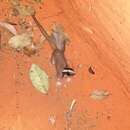Biology
provided by Arkive
There are very few records of the bushy-tailed opossum, thus little is known about its biology and ecology (5). Like other American opossums, it may be nocturnal and probably feeds on insects, seeds, fruits and eggs (1). Due to their large opposable big toe, it is presumed that the bushy-tailed opossum is arboreal, spending most of its time in the trees (2). However, some specimens have been captured in pitfall trips placed on the ground, showing that it must occasionally use the lower parts of the forest and sometimes move on the ground (5).
Like other marsupials, their unique mode of reproduction sets them apart from other mammals. The young begin development inside a thin-shelled egg within the mother, and are very poorly developed at birth (3). The young is then carried in a pouch on the abdomen of its mother where it suckles her milk and most development takes place. Initially the young remain attached to the teat, but will later begin to crawl about her body. Toward the end of lactation, the young leaves the pouch and follow their mother closely (3)
Conservation
provided by Arkive
At present there are no known conservation measures in place for this vulnerable opossum. A lack of information regarding its range, biology and ecology may be impeding any conservation efforts. Thus further studies are critical and urgent for understanding, recording and preserving this little known opossum (5).
Description
provided by Arkive
This rare and poorly known animal is an American opossum, a group of marsupials linked to their Australian relatives through their unique mode of reproduction (3). In appearance it somewhat resembles a dormouse, in fact its scientific name, Glironia, comes from the Latin Glir meaning dormouse; venusta means elegant or charming (2). Its nose is long and pointed with long, tactile hairs (3), and the blackish ears are large, oval and naked (2), providing acute hearing (3). The bushy-tailed opossum's fur varies from soft and velvety to dense and woolly, and is fawn or cinnamon-brown on top, grey to buffy-white below (2). As its common name suggests, the tail is thickly furred and bushy (2). A broad dark brown to black stripe extends from the ears, down through each eye to the nose. A narrow greyish-white band extends along the middle of the head, from the neck down to the nose, separating the dark eye stripes and giving the appearance of a mask (2). Bushy-tailed opossums have hands and feet that are well adapted to grasping tree trunks and branches, and possess an opposable big toe on the hindfoot.
Habitat
provided by Arkive
The busy-tailed opossum is known to inhabit dense, humid, tropical forests (2), and semi-deciduous, dry seasonal sub-montane forest (5).
Range
provided by Arkive
The range of the bushy-tailed opossum is not fully known, but specimens have been collected from the Amazonian regions of Bolivia, Brazil, Ecuador and Peru (2) (4), and from the Paraguay River basin, Brazil (5).
Status
provided by Arkive
Classified as Vulnerable (VU) on the IUCN Red List 2007 (1).
Threats
provided by Arkive
Habitat destruction is the primary threat facing this forest-dwelling opossum, and numbers are thought to be declining as a result (1). Forests within its range are being logged or converted for agriculture. Small remnants of forest are being rapidly destroyed, fragmented and isolated within growing areas of cattle pasture (5). Shortly after one of the specimens was collected in Brazil from a forest patch surrounded by agricultural settlements, the forest was burned (5).

